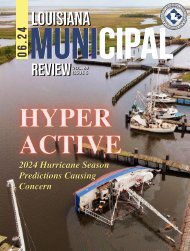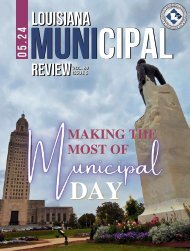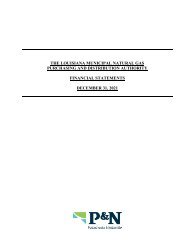October 2023
You also want an ePaper? Increase the reach of your titles
YUMPU automatically turns print PDFs into web optimized ePapers that Google loves.
Welcome to<br />
Wildfire Season<br />
Lasting Longer and Raging Harder<br />
For a little over a month, Louisiana<br />
has been inundated with<br />
wildfires. People are shocked,<br />
as things like this only happen<br />
in places like California,<br />
right? Well, not anymore.<br />
Since August 22, more than 60,000 acres<br />
of Louisiana land has been scorched,<br />
some by blazes of more than 300 feet<br />
high. That’s 60,000 acres in just over a<br />
six weeks in a state normally seeing a<br />
much smaller fire loss of around 8,000<br />
acres annually. Just one of this year’s<br />
fires – Tiger Island – saw an acreage loss<br />
of more than half that 60,000 amount.<br />
Those numbers, as we leave our low level<br />
rainy season and enter a high impact<br />
dry season, aren’t good at all. On top of<br />
that, many families have been displaced<br />
due to the rapid strength of these wildfires.<br />
When we hear about devastation<br />
such as this during hurricane season,<br />
we do what Louisiana does best – we<br />
sit up, we take notice, and we ask how<br />
we can help. For some reason, however,<br />
that doesn’t seem to be on the radars of<br />
a lot of people across the state when it<br />
comes to wildfires. If someone doesn’t<br />
burn garbage in their yard, they feel this<br />
doesn’t affect them. But as we’re seeing<br />
now - how very wrong people can be.<br />
Louisiana has had wildfires in the past,<br />
but not to the extent we’re seeing them<br />
in <strong>2023</strong>. There are numerous reasons for<br />
this sudden onslaught, with weather<br />
conditions and a lack of preparation being<br />
top of the list. For example, embers<br />
can travel in a dry wind, and when those<br />
embers drop, they act as additional fire<br />
starters with new epicenters. Greater<br />
Baton Rouge area meteorologist and<br />
trusted LMA friend Jay Grymes explains<br />
in more detail.<br />
“All you need is one spark or ember to<br />
travel ten or twenty yards, and you’ve<br />
got a new hotspot. That’s what’s making<br />
the containment of these fires so difficult.<br />
And the driving force this year is the<br />
near record<br />
drought.<br />
When you<br />
have this<br />
incredibly<br />
dry environment,<br />
particularly<br />
when<br />
you’re the<br />
wettest state<br />
in the lower<br />
48, it’s off<br />
Jay Grymes<br />
the charts<br />
abnormal. Add to that a record warmer<br />
than normal summer that’s the hottest<br />
ever on the record books, and everything<br />
in the environment is kindling just<br />
waiting to pop.”<br />
And the type of fire doesn’t matter when<br />
lives are on the line.<br />
“Although arson has happened, many of<br />
the fires have also been caused by lightning,<br />
for example Ascension and Livingston.<br />
The wind driven factor is also key<br />
Page 8<br />
LMR | OCTOBER <strong>2023</strong>
















